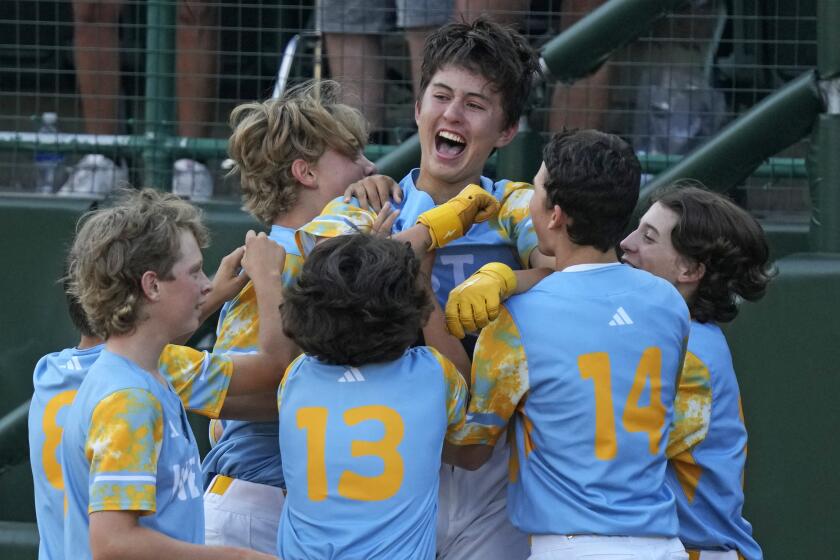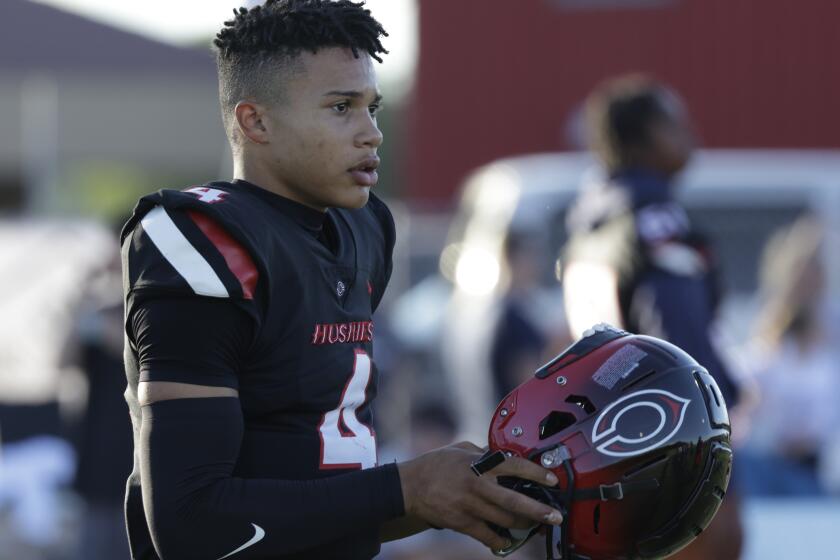La Quinta Is Getting Back on Track
It wasn’t long ago that La Quinta was a power in Garden Grove League football.
In 1985, the Aztecs went 11-3 and reached the Southern Section Central Conference championship game, where they lost to Saddleback. In 1989, they were 9-5, and in 1990, they were 11-1, reaching the playoffs both years.
But La Quinta did not have another winning football season until this year. This season, the Aztecs are 6-2 and regaining some respect.
To understand how far La Quinta football had fallen, consider that from 1993 through 1997 the Aztecs were 6-44 overall and 2-29 in league play. They had lost 12 consecutive Garden Grove games until upsetting Santiago, 8-7, on Oct. 1.
Although there are no assurances the Aztecs will end their playoff drought--only three of the league’s seven teams are guaranteed a spot--just having a winning season has regenerated positive feelings about the team on campus.
“It’s a lot different,” Aztec Coach Jeff Veeder said. “Students I don’t know are coming up and talking to me about football. They are wearing sweatshirts and jerseys with the school name.
“Two to three years ago, I don’t think anyone knew we had a team.”
It’s not only students who have responded. Quarterback Thi Huyhn said when the team went through an 0-10 season last year, “the teachers and administrators wouldn’t say anything to us. Now they ask us what time the games are and say they will come.”
Athletic Director James Perry said he was most happy for the 20 seniors on La Quinta’s 39-player roster.
“This group of seniors has been through a lot,” Perry said, “and I feel you can’t become a good team unless you’ve been a bad team for a while. They now know what it takes to be a good team.
“I think the experience will give them a tremendous background when they become adults. Some of the lessons they will take from here, in working with people and working through adversity, they will use the rest of their lives. Those are the things athletics are supposed to teach.”
Perry said La Quinta’s football decline actually began before 1993.
The student body’s ethnic makeup, which in the 1970s was approximately 80% white and 20% Latino, began to change as more Asian families--primarily Vietnamese--moved into the area.
Today La Quinta’s student population (1,523) is approximately 60% Asian, 20% white and 20% Latino with a smattering of African Americans, Samoans and those from the Middle East, according to Principal Jim Monahan.
“The first [new wave] of kids I think were primarily from Southeast Asia,” Perry said. “They had no basis of reference in American high school life. There was a tremendous emphasis on academics and college entrance--as it should be. The parents knew education was the primary way [for a better life] for their kids.
“For a long time the main interest was grades, college prep courses, SAT scores and that was it. But they’ve also learned that colleges and universities are more interested in well-rounded students who will do more than just go to class and the library. We now have kids who have grown up playing age-group sports like soccer, baseball and football.”
Perry also credits Veeder for bringing stability to the head coaching position. After Roger Takahashi (now at Los Amigos) left in 1991 and before Veeder took the job in 1996, La Quinta went through three coaches in four years.
“No matter how good your kids are, the team won’t be good without continuity in the program,” Perry said.
Veeder said getting athletes from other sports to come out this season has given the Aztecs a boost. Wide receiver Josue Pena, defensive back Anthony Garcia, and linebacker Alex Valdavia play on La Quinta’s baseball team.
“We are a little more athletic,” Veeder said.
But Veeder--who in three years pushed for and got a new weight room, team locker room and expanded coaches’ office--frets that this season could be an aberration rather than the start of big things.
His 37-player junior varsity team quit before the season began. “They said it was too hard,” said Veeder, who is left with 17 freshmen. “There is a renewed interest; some may show up again next spring, but now they’ve lost a year and it’s almost like starting over.
“Everyone is more physical than we are. For us to survive we have to execute and not make mental errors. The kids thought they could win this season, but didn’t know for sure because they hadn’t won.”
Still, league opponents are having to take their games against La Quinta more seriously than in the past.
Santiago Coach Ben Haley warned his team that La Quinta was improved. But the Cavaliers, who defeated the Aztecs, 56-13, last year, paid little heed and paid a big price.
“La Quinta is very well coached, and has been doing things well for a long time,” Haley said. “I knew this year they would be good with those seniors.
“Fumbling four times inside the 10 didn’t help us. But our kids admit now they looked past La Quinta and that game the Aztecs played well. They should be proud of everything they are doing this year.”
Huyhn, who has passed for 950 yards and six touchdowns, said it was important for La Quinta to get into the playoffs.
“If we do that, it will help keep kids here who would transfer to other schools,” Huyhn said. “The freshman players will come back. Since I’ve been here, about 75% of the freshman team would leave or stop playing. Most of the time they would say, ‘I don’t want to play for a loser.’ ”
No matter what happens, Valdavia believes this team has broken the cycle of indifference and disrespect for the football teams that follow.
“They’ll forget the bad years and focus on the future. I think our team is the first building block in a new foundation of hope to build on. But we had to have a good year. That was the key.”
Get our high school sports newsletter
Prep Rally is devoted to the SoCal high school sports experience, bringing you scores, stories and a behind-the-scenes look at what makes prep sports so popular.
You may occasionally receive promotional content from the Los Angeles Times.



